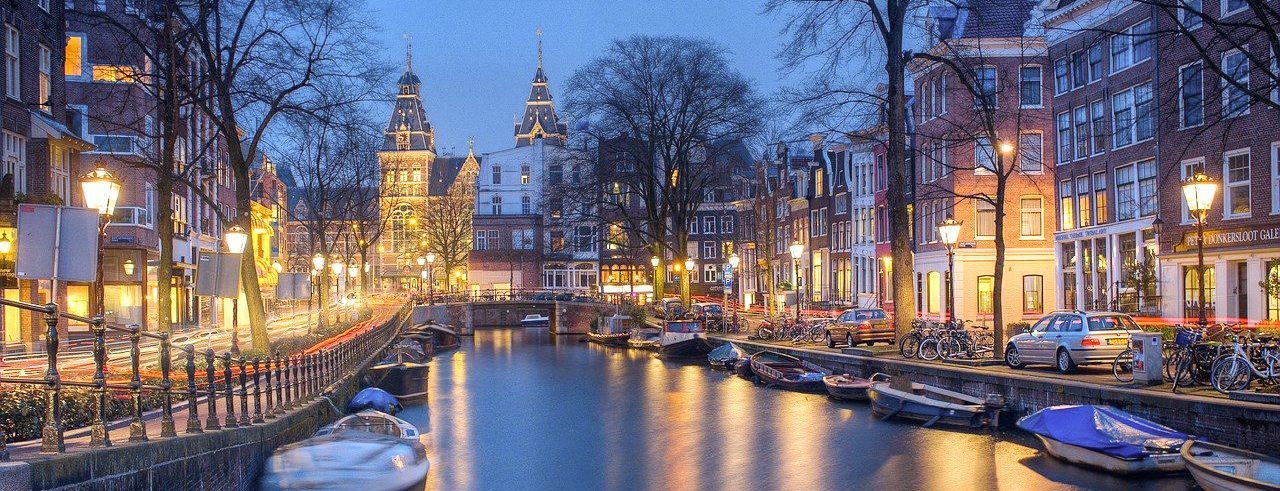Walking The Dales Way: 81 Miles of Beauty and Charm
This post may contain affiliate links. If you make a purchase through these links, we will earn a small commission at no extra cost to you. For more information, please check our privacy policy. Thanks!
Do you love a challenge? Steve and I do, so when we first learned about the Dales Way, we were excited. It seemed like the perfect adventure for us. We planned our walk for June 2020, but the pandemic put our trip on hold for two years. In July 2022, Steve and I finally got to walk the Dales Way.
We spent ten days in northern England and walked on eight of them. We will never forget the beauty of the Yorkshire Dales and the challenge of doing our first long-distance walk.
Read more to discover what the Dales Way is all about, our experiences, and where to find practical information for your Dales Way walk.
Note – all money is in U.S. dollars unless otherwise noted.
About The Dales Way
What is The Dales Way?
The Dales Way is an 81-mile* (130 km) walk in the Yorkshire Dales and the Lake District of England. It runs north and south from Ilkley, West Yorkshire, to Bowness-On-Windermere, Cumbria. It is an easy to moderate walk that follows several waterways and takes you over the rolling hills of the dales. It passes through many farms (more on that later) and several villages and hamlets.
*The length of the walk varies depending on the source. I have seen everything from 78 miles to 83 miles. However, the signs at the beginning and end of the walk say 81 miles.
Facts about the Dales Way
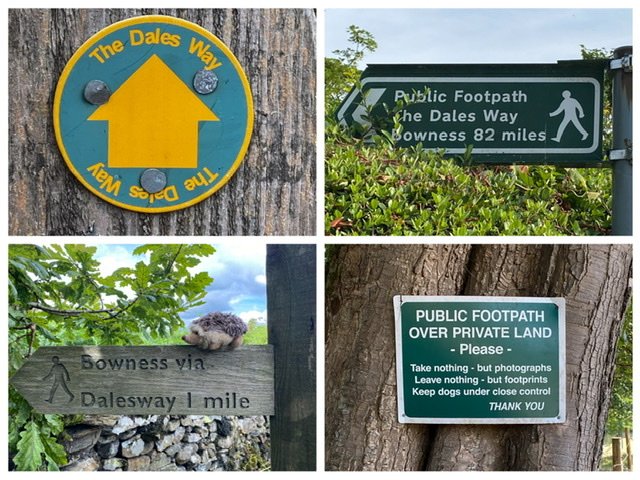
Signs along the Dales Way
The first Dales Way walk was in 1969.
The Dales Way was created by the Ramblers Association, specifically the West Riding Ramblers led by Tom Wilcock and Colin Speakman. The Ramblers Association is a British charity that works to protect and expand the places people go walking. You can read more about the birth of the Dales Way here.
According to Colin Speakman in this 2019 article, about 4,000 people walk the Dales Way every year and spend an average of £1,000 ($1,200).
A fair part of the walk is on paved roads, particularly near towns and villages.
The path goes through two national parks, the Yorkshire Dales National Park and the Lake District National Park.
It is possible but challenging to complete the walk in four days. A more reasonable number of days is six to eight. We chose to do the walk in eight days, with a rest day after the fifth day.
England and Wales have a right to roam. This gives walkers the legal right to travel over mountains, moorland, heath, downland, and common land without having to stay on paths. Even so, some farmers post signs requesting walkers to remain on the trail or run a fence along the trail to keep walkers in one area.
Despite more than a century of effort, the right to roam didn’t become law until 2000. It then took five years after it became law before the practicalities were worked out and it was put into practice. Here is the history behind the right to roam.
The Romance and The Reality
Imagine doing nothing for days but walking through a serene landscape, then spending the evening at a country inn where you share a few pints with other walkers and enjoy some well-earned sustenance and slumber.
This is how I imagined our walk would be. And it was, to a point.
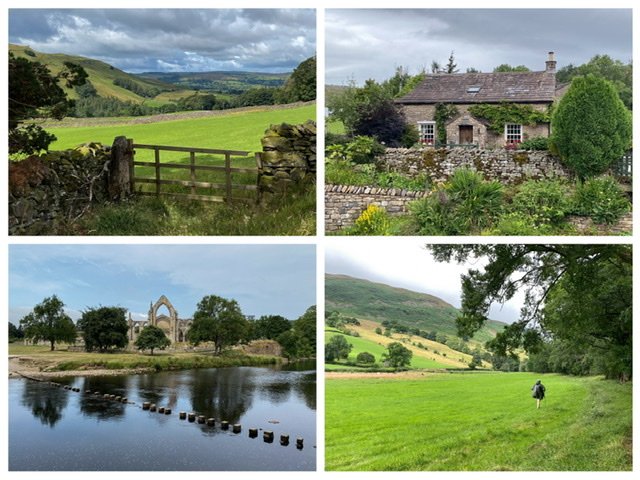
A few scenes from our Dales Way walk
It really is this beautiful, but there are a few things you should know.
You will see endless expanses of greenery and mile upon mile of stone wall. But much of your time will be spent looking down, first to avoid a turned ankle or worse on the uneven terrain and second to avoid the ever-present animal waste.
Because that is what none of the Dales Way walkers mention in their articles. There is sheep, cattle, and horse dung everywhere. Obviously, it is in the fields. It is also on the roads. If you are lucky like Steve, you will be congested and not smell it very much.
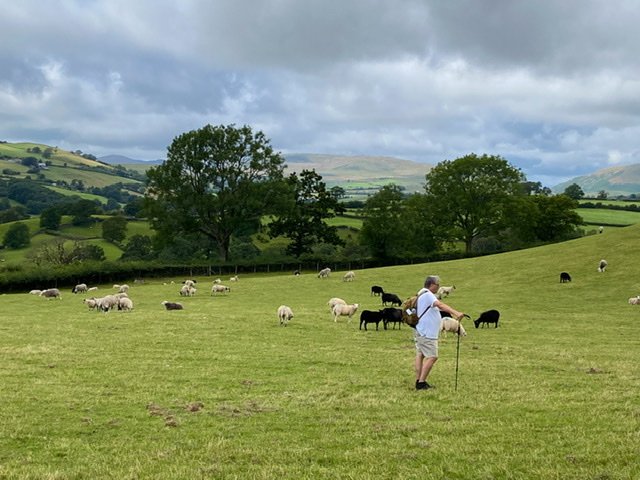
You will see enough sheep to last you a lifetime.
You will open and close far too many gates.
You will also climb many stiles. While we found them all doable, they weren’t always easy. Sometimes there was a large distance between steps or a very narrow opening.
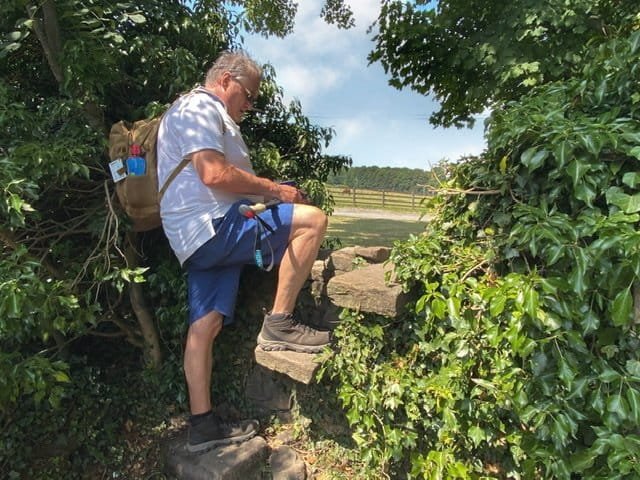
Steve climbing one of many stiles
A Surprising Risk
Walking is a low-risk endeavor, but it is not risk free. If you develop a medical emergency on the trail, there may not be a way to summons help (cell service was spotty), and it may be a long time until help arrives.
However, the most surprising risk was one we didn’t learn about until we were on the trail. That is the danger of being killed by a cow.
Our first cow experience was early in our walk. We entered the grounds of one farm and started following the riverside path. We could see many cattle gathered along the river and on the path. We approached them slowly, and one cow started walking toward us. We turned and slowly walked away from her.
She headed back to the group, but the cows remained on the path, so we decided to take a detour. We walked towards the road, only to find the fence along the road was topped with barbed wire. We saw a gate without barbed wire on top, but it was locked. So we did the next best thing, we climbed over it.
This detour set us back a little, but we found out we had made a wise choice when we met some hikers who told us about the risk of being killed by a cow.
On average, cows kill five people in the U.K. every year. As you would expect, cows protecting their young are particularly dangerous. Farm workers are at the greatest risk, but walkers have been crushed or trampled by cows as well.
Here is an article from The Independent from 2015 that talks about cow deaths in Britain.
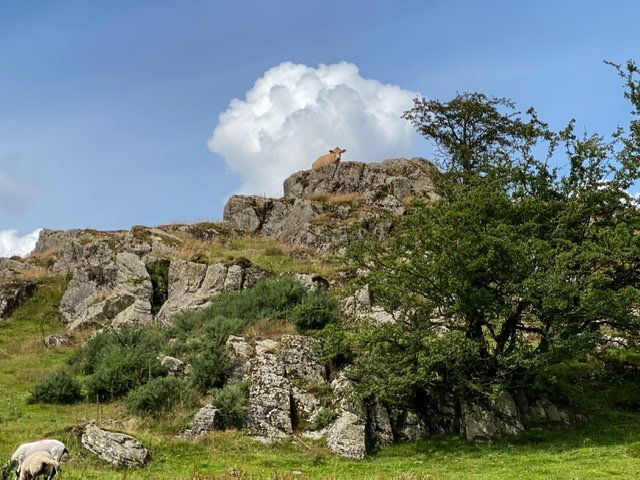
How we like our cows – far away
Options and Costs
According to the data above, the average cost to walk the Dales Way is $1,200.
You can keep your cost lower than this if you carry all your gear and camp along the way. Here is a list of fifteen campsites on the Dales Way.
A more pricey option is to book your lodging directly and either carry all your gear or have what you don’t need on the trail moved from lodging to lodging by a service.
The easiest but most expensive way is to use a tour company to make arrangements for you.
Since this was our first long-distance walk, we used a tour company. There are several companies from which to choose. We chose Mickledore, a company that specializes in self-guided walking and cycling holidays in the U.K. We were happy with them.
Their services included arranging nightly lodging with breakfast, providing packed lunches, arranging daily transportation of our luggage, and providing maps, an itinerary, and a guidebook.
Sherpa Van is another popular service. They offer baggage transfers and accommodation bookings. We did not use them, so I cannot make a recommendation, but you can see their services and prices here.
If you use a tour company, you will still have to make plans for each night’s dinner. Mickledore advised us to make reservations in advance to be sure we had a place to eat each night.
Our Experience
How We Came to Walk The Dales Way
Our inspiration to walk the Dales Way came from Simon Fairbairn and Erin McNeaney at Never Ending Voyage. You can read about their experience in “The Ultimate Guide to Northern England’s Dales Way.”
Like Simon and Erin, we are not experienced hikers, yet something about this idea stuck with us. I think it was a combination of the uniqueness and the challenge, along with the assurance that it would be doable for two retirees in relatively good shape but far from athletic.
What We Loved
The peaceful, easy feeling – When all you have to do all day is place one foot in front of the other while soaking in the beautiful scenery, stress becomes a distant memory.
Meeting the best people – Whether they are fellow walkers, B&B staff, or random folks on the road, you will not find kinder, friendlier, more helpful people than the folks who live in northern England.
Seeing no chain hotels or restaurants – We did not see one Ramada or McDonald’s during our walk. Every place we stayed and every restaurant we ate at appeared to be a locally owned business.
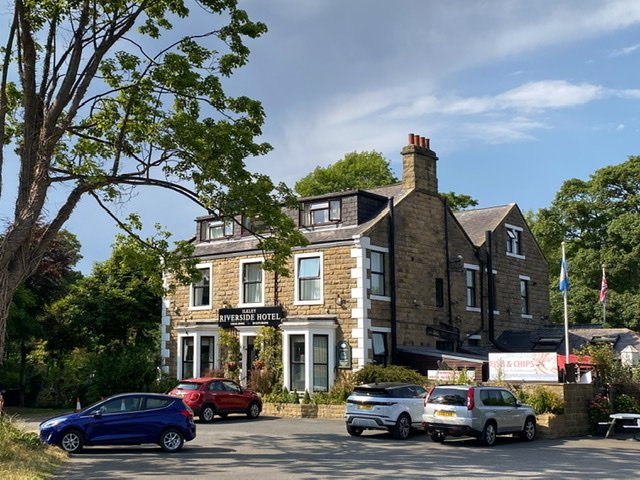
Our first stay during our walk – the Riverside Hotel in Ilkley, England
The Shepherds Cottage Luxury B&B – Most of our accommodations were basic, 2 or 3-star rooms. They were more than adequate, but when we reached the town of Ribblehead and walked into our room at Shepherds Cottage Luxury B&B, we were blown away.

Our room at Shepherds Cottage. I doubt many shepherds had it this good.
Talking with Tony – Another great stay was at the Lakeland Hills B&B in Burneside. The lodging is in Tony’s house, so it was a different experience than at the previous B&Bs. The room and food were top-notch, but the best part was talking with Tony over breakfast.
What We Didn’t Love
The poop – Even so, we managed to keep it off our boots all but one day.
The trains – We spent a few days in Manchester before heading to Ilkley by train. Our train to Ilkley was canceled, and the replacement only went part way. Once we arrived at that stop, we had to grab a random worker at the small station to find out which train to take next. We did not see a ticket office.
On the way back to Manchester, the direct ride was changed to two trains after the journey had started.
The trains themselves were fine. Hopefully, England’s train travel issues will be straightened out soon.
The cost – It’s no secret that the U.K. is expensive.
The narrow roads – At least I didn’t like them. Far too often, we would walk on a road that was only wide enough for one car. When the road had vegetation or stone walls on both sides, there was very little room when cars passed. Even worse, the drivers seldom slowed down.
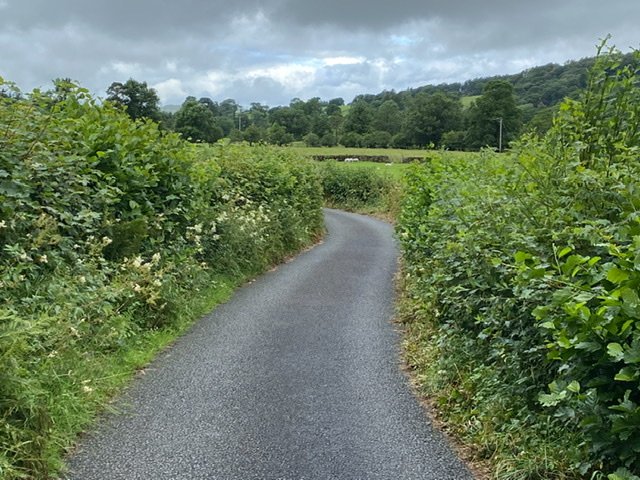
One of the narrow roads
Memorable Experiences
Record heat – England was experiencing a record-breaking heatwave on our first day of walking. Luckily it was a short 6 miles (10 km). The temperature reached 100 degrees F (38 C) in the afternoon. Fortunately, the heatwave was short-lived, and the temperatures were normal for the rest of our walk.
Lost guidebook – Mickledore provided a fantastic guidebook complete with hand-drawn maps. We found it very helpful the first day, but not so much after that since we lost it on day one! Mickledore mailed a replacement, but no one was at our B&B to sign for it, so we never got it.
Getting lost, a lot – We missed quite a few signs, adding miles to our journey.
Our Strangest Experience – Screaming Maggie
We had a strange experience at one B&B. We arrived about 30 minutes before check-in. We didn’t see anyone around, so we sat on a stone wall (is there any other kind in Yorkshire?) to wait. A few minutes later, a man came by and called into the house, “Maggie, your guests are here.”
Maggie was recovering from surgery and let us know she did not like being disturbed. She complained that we were early. This was so different than the hospitality we previously found in Northern England.
But that wasn’t the weird part. The owner, Jim, came back shortly, and while we were settling into our room, we could hear Maggie haranguing Jim over his lack of concern for her. She was yelling, swearing, and slamming doors!
There were two more tirades that afternoon, including one while Jim was ironing towels as Maggie sat nearby and complained. After all this, we didn’t see or hear her anymore. We still wonder why the screaming stopped.
Beside that, our stay was satisfactory. Jim never mentioned these incidents and did all he could to be a good host.
What It Cost Us
This experience was a budget buster. The total cost was $4,200 and breaks down like this:
| Item | Cost in USD |
|---|---|
| Flight to Manchester | $600 |
| Trains and buses | $100 |
| Mickledore fee - rooms, breakfasts, lunches, map, book, intinerary for 8 walking days | $2,300 |
| Mickledore - two extra nights with breakfast | $400 |
| Dinners | $700 |
| Lunches where not provided and drinks | $100 |
| Total | $4,200 |
A few notes about our costs:
Several weeks before our trip, we booked an EasyJet flight from Budapest to Manchester for just over $200 for both of us. Shortly after we booked it, the flight was canceled. The replacement flight with Ryanair was almost $600.
Since we travel full-time, I only include the transportation cost of getting somewhere in the cost of visiting that location. Therefore, I am including only the cost to fly to England here but not the cost to fly out.
Our train trip from Manchester to Ilkley cost $70. When we bought tickets to return to Manchester at the end of the walk, it was only $24. The price can vary greatly depending on what time you choose to ride. I have also heard that buying tickets well in advance will save you quite a bit of cash.
We chose to eat dinner at nice places. This cost could certainly be lower.
I did not include the cost of supplies since this varies greatly. Many people will already have most or all of the items they need for this walk.
What We Would Do Differently
Truly waterproof boots – Steve and I thought our boots were waterproof, but a few minutes of walking over wet fields proved otherwise. We both wore Columbia boots. I had mine for several years, had worn them in the snow with no problem, and gave them an extra coating of waterproofing before our hike. Even so, they leaked. Steve’s were new Columbia waterproof boots, and they leaked too.
We noticed that many walkers had the same problem. Since my boots are ready to be replaced, I will be looking at the waterproof ratings closely.
Skip packed lunches – we paid $160 to have a packed lunch each walking day. This generally included a sandwich, some cookies, other packaged snacks, and an apple. We had a good breakfast each morning and found that we did not eat much on the trail. If we book future walks through a service, we will forgo the lunches and pack a few snacks.
Study the maps more – Steve had studied the maps before our walk and spent a lot of time annotating the guidebook, but I believed that the signposts would be adequate. They weren’t. Much of the trail is well marked, but the section between the two national parks is not. It is also easy to miss a signpost.
Secure maps and guidebook – When you’re tired and hot like we were after our first day of walking, it is easy to lose things. One of our party, who shall remain nameless, didn’t realize they had dropped our guidebook until a few hours later. We returned to the site the next morning, but we didn’t find it.
Skip the rest day – We weren’t sure how our senior bodies would react to days and days of walking, so we planned a rest day in the middle of our hike. This turned out to be unnecessary since the walk was not strenuous. We stayed in the charming town of Dent and ironically ended up hiking up a hill after we were told there was a fantastic view from the top. We never got to the top because we weren’t wearing the proper footwear to walk on the stone-covered path.
Skipping the rest day would have saved us $200 on lodging and $85 on meals.
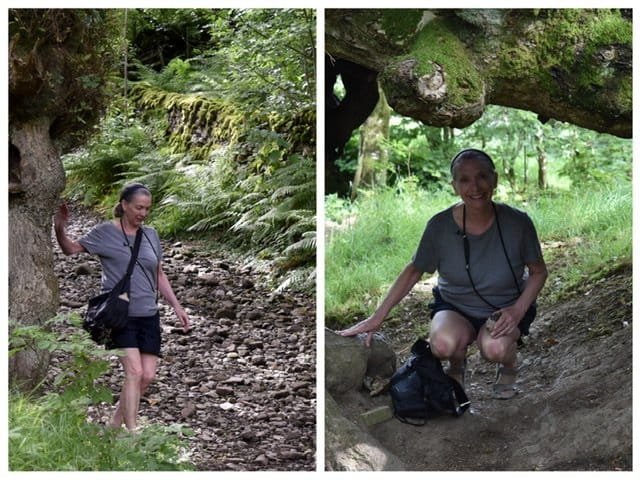
Why wouldn’t you go for a hike on your rest day?
Book the extra night at the end directly – We had decided to spend an extra night in Bowness-on-Windermere at the end of our walk. We booked that night through Mickledore for $200. Our room was on the top floor, so it was fun carrying our suitcases up four flights. It was cute but small and certainly not worth $200 per night.
Practical Stuff
Learn More About Walking the Dales Way
The official website of The Dales Way Association is full of helpful information for learning more about the route and planning your walk.
Here is more helpful information about walking the Dales Way from the Waypoint51 website.
You can read more firsthand experiences of the Dales Way on the Dales Way Association website.
Good to Know
Steve and I each had a pair of hiking poles but ended up only using one each. Many people walk the Dales Way without poles, but we found them helpful for navigating muddy and rocky inclines. We also used them to steady ourselves when climbing over stiles.
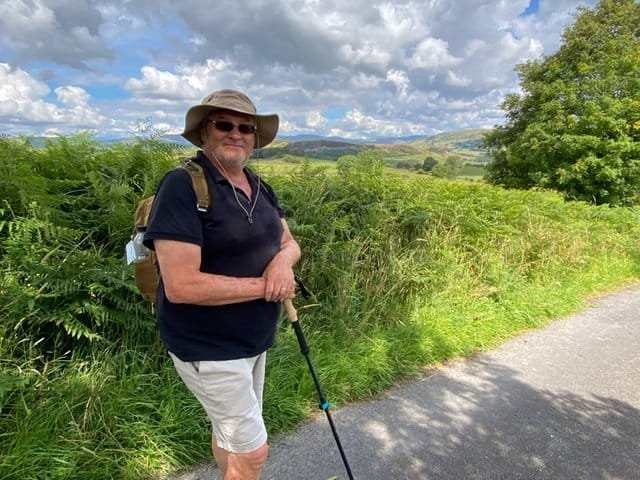
Steve with his hiking hat and pole
Rain gear, including a backpack cover, is necessary. After all, you can’t get emerald fields without rain. Luckily we only had light rain. Steve used a $6 poncho that kept him and his backpack dry, even if it did make him look like Quasimodo. I wore my Eddie Bauer rain jacket with hood and used a backpack cover, which also worked fine.
It is advisable to bring cash. We were able to pay for everything with a credit card, but if you run into a problem, you won’t find ATMs around every corner.
The same goes for supplies. Steve grabbed his poncho at Black’s in Manchester, but when we tried to find a shop along the Dales Way to replace our guidebook, the store had closed at 4 p.m. And since many of the villages along the Dales Way are tiny, there are a limited number of stores.
The Final Verdict
Despite the poop, the cows, and the countless stiles, Steve and I loved this experience and plan to do more long-distance walks. We basked in breathtaking beauty, met incredible people, and saw a lifestyle that defies the twenty-first century.
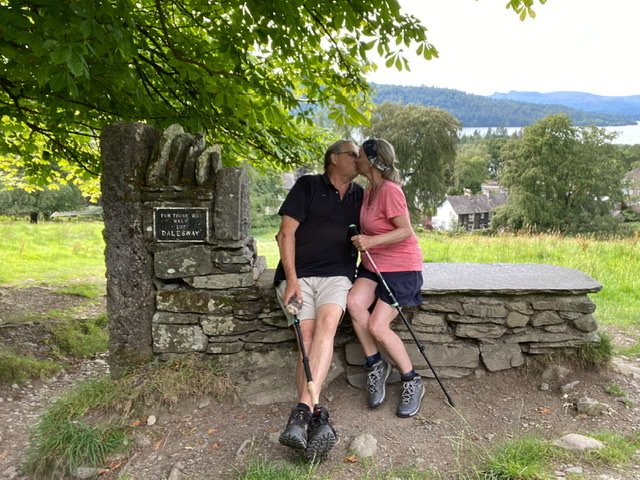
At the end of our walk
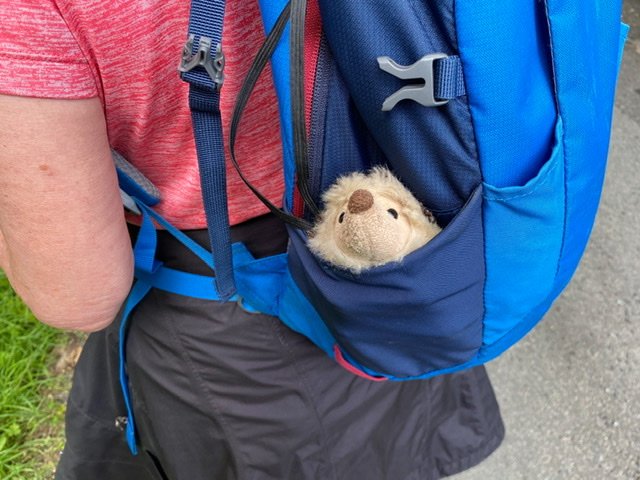
Hedgemeister had it easy.
Have you walked the Dales Way? If so, Steve and I would love to hear about your experiences. Drop us a message in the comments section below.
Happy traveling,
Linda
Before You Go
If you enjoyed this post, please consider subscribing to Wind and Whim. You’ll get an email notification each time we publish a new post and get our short and sweet monthly newsletter in your inbox, too! If I’ve given you valuable information and you want to show your appreciation, you can buy me a coffee.
